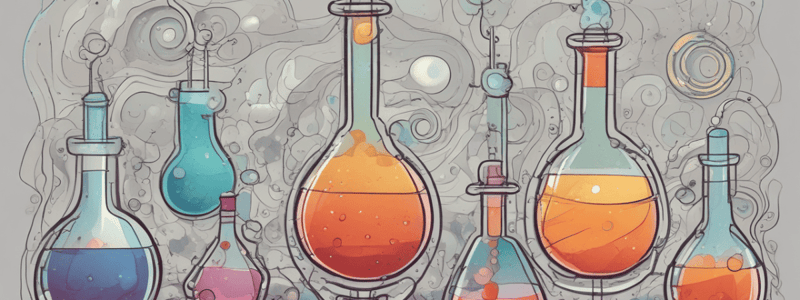Podcast
Questions and Answers
In the halogenation of alkenes, what is the result of the end-on approach of Br2 to the double bond?
In the halogenation of alkenes, what is the result of the end-on approach of Br2 to the double bond?
The double bond is polarized and Br2 is split into Br+ and Br-.
What type of bond is formed when Br+ gains an electron from the double bond?
What type of bond is formed when Br+ gains an electron from the double bond?
A covalent bond.
What is the definition of a free radical?
What is the definition of a free radical?
A highly reactive species with an unpaired electron.
What is the purpose of UV light in the free radical substitution reaction?
What is the purpose of UV light in the free radical substitution reaction?
What is the result of the attack of Br+ on the C=C bond?
What is the result of the attack of Br+ on the C=C bond?
What is a requirement for the ionic addition of Br₂, Cl₂, or HCl across C=C in ethene?
What is a requirement for the ionic addition of Br₂, Cl₂, or HCl across C=C in ethene?
What catalyst is used in a reaction such as the ionic addition of Br₂, Cl₂, or HCl across C=C in ethene?
What catalyst is used in a reaction such as the ionic addition of Br₂, Cl₂, or HCl across C=C in ethene?
What type of reaction involves the removal of a small molecule from a large molecule, leaving a C=C behind?
What type of reaction involves the removal of a small molecule from a large molecule, leaving a C=C behind?
What is the product of the reaction between a primary alcohol and sodium?
What is the product of the reaction between a primary alcohol and sodium?
What is the term for the chemical decomposition of a substance by water, resulting in the breakdown of the substance and water itself?
What is the term for the chemical decomposition of a substance by water, resulting in the breakdown of the substance and water itself?
What is the term for the reaction between a carboxylic acid and an alcohol, resulting in the formation of an ester?
What is the term for the reaction between a carboxylic acid and an alcohol, resulting in the formation of an ester?
What is the term for the joining together of small molecules to form larger molecules?
What is the term for the joining together of small molecules to form larger molecules?
Flashcards are hidden until you start studying




